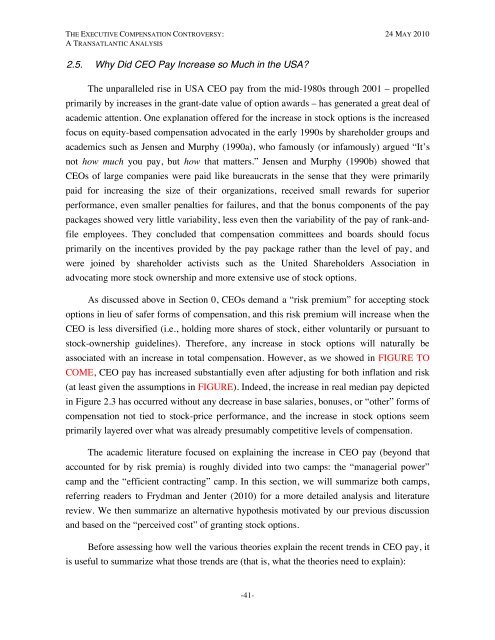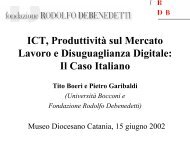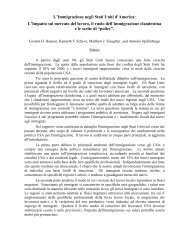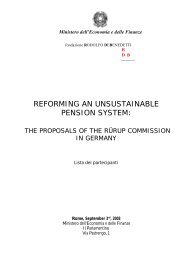The Executive Compensation Controversy - Fondazione Rodolfo ...
The Executive Compensation Controversy - Fondazione Rodolfo ...
The Executive Compensation Controversy - Fondazione Rodolfo ...
You also want an ePaper? Increase the reach of your titles
YUMPU automatically turns print PDFs into web optimized ePapers that Google loves.
THE EXECUTIVE COMPENSATION CONTROVERSY: 24 MAY 2010A TRANSATLANTIC ANALYSIS2.5. Why Did CEO Pay Increase so Much in the USA?<strong>The</strong> unparalleled rise in USA CEO pay from the mid-1980s through 2001 – propelledprimarily by increases in the grant-date value of option awards – has generated a great deal ofacademic attention. One explanation offered for the increase in stock options is the increasedfocus on equity-based compensation advocated in the early 1990s by shareholder groups andacademics such as Jensen and Murphy (1990a), who famously (or infamously) argued “It’snot how much you pay, but how that matters.” Jensen and Murphy (1990b) showed thatCEOs of large companies were paid like bureaucrats in the sense that they were primarilypaid for increasing the size of their organizations, received small rewards for superiorperformance, even smaller penalties for failures, and that the bonus components of the paypackages showed very little variability, less even then the variability of the pay of rank-andfileemployees. <strong>The</strong>y concluded that compensation committees and boards should focusprimarily on the incentives provided by the pay package rather than the level of pay, andwere joined by shareholder activists such as the United Shareholders Association inadvocating more stock ownership and more extensive use of stock options.As discussed above in Section 0, CEOs demand a “risk premium” for accepting stockoptions in lieu of safer forms of compensation, and this risk premium will increase when theCEO is less diversified (i.e., holding more shares of stock, either voluntarily or pursuant tostock-ownership guidelines). <strong>The</strong>refore, any increase in stock options will naturally beassociated with an increase in total compensation. However, as we showed in FIGURE TOCOME, CEO pay has increased substantially even after adjusting for both inflation and risk(at least given the assumptions in FIGURE). Indeed, the increase in real median pay depictedin Figure 2.3 has occurred without any decrease in base salaries, bonuses, or “other” forms ofcompensation not tied to stock-price performance, and the increase in stock options seemprimarily layered over what was already presumably competitive levels of compensation.<strong>The</strong> academic literature focused on explaining the increase in CEO pay (beyond thataccounted for by risk premia) is roughly divided into two camps: the “managerial power”camp and the “efficient contracting” camp. In this section, we will summarize both camps,referring readers to Frydman and Jenter (2010) for a more detailed analysis and literaturereview. We then summarize an alternative hypothesis motivated by our previous discussionand based on the “perceived cost” of granting stock options.Before assessing how well the various theories explain the recent trends in CEO pay, itis useful to summarize what those trends are (that is, what the theories need to explain):-41-









